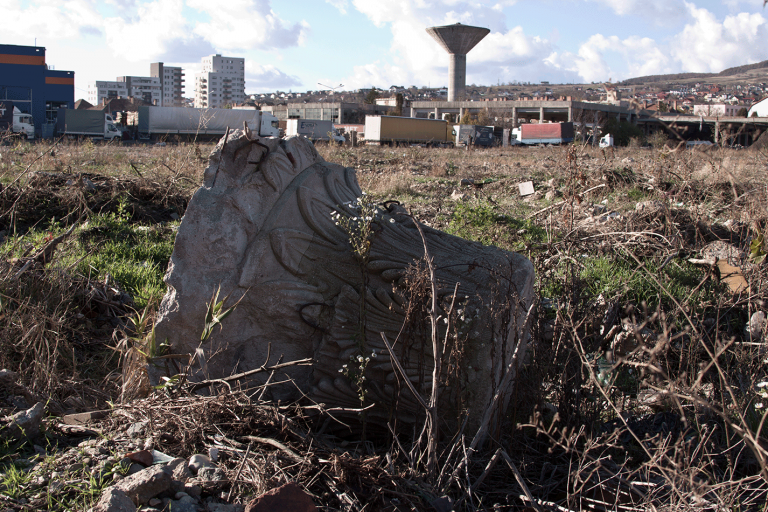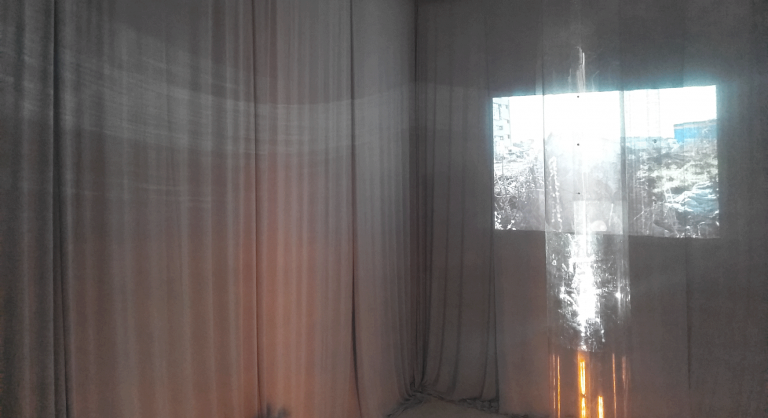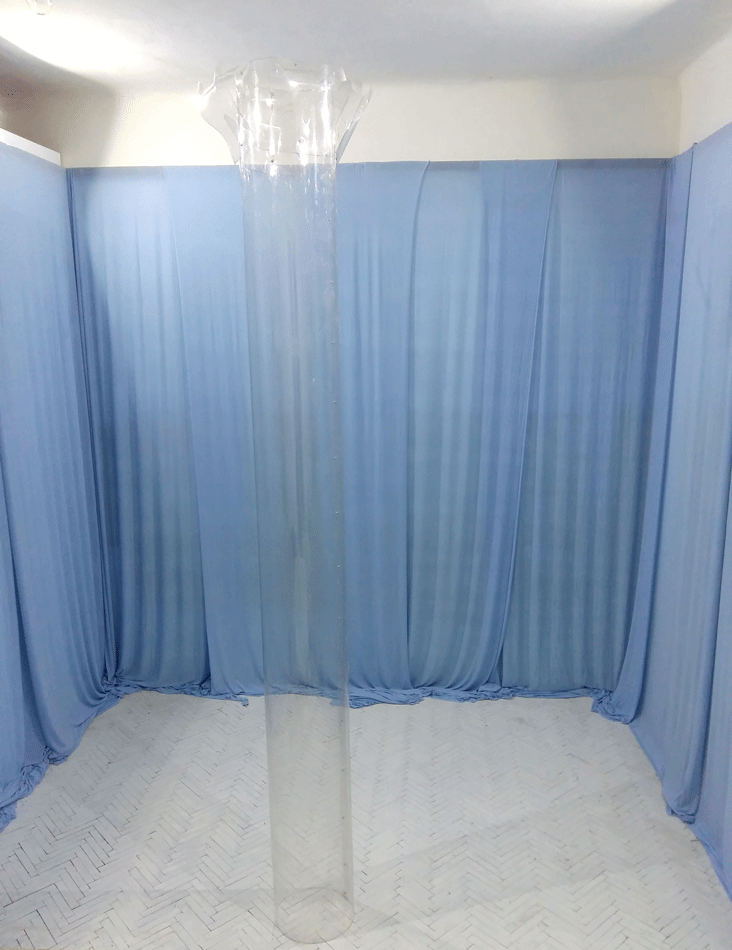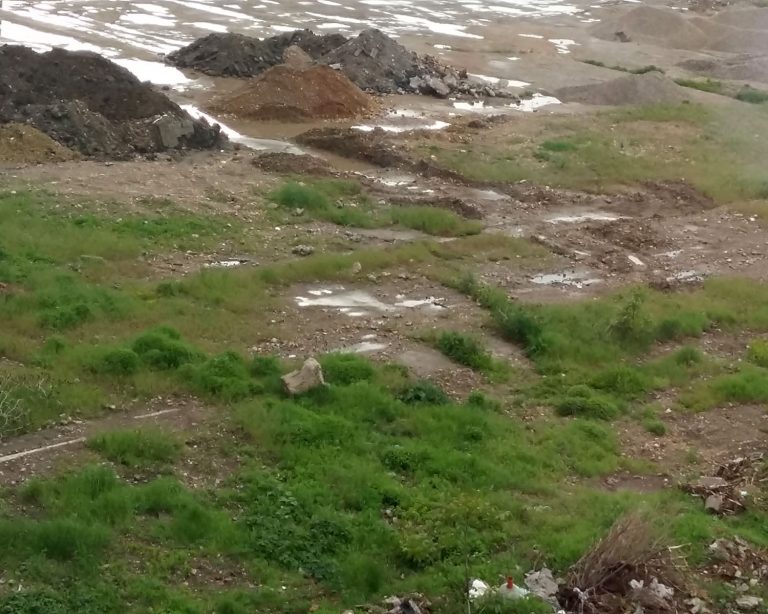dysplacement
Site specific installation. Temporary sculpture
Atelier Patru, Cluj Napoca, Romania, November 2017
possible with the support of:
Atelier 4, Voica Puscasiu, Dan Tamas, Mihaela Tatar, Alexandru Tatar
Working with a found object as such, and as a concept in the post-human era, the show Dysplacement by Alexandra Tatar is a comment (which can be read as poetry as well) on the contemporary theme of belonging in relation to subjects, identities and places. One of the artistic practices falling under the umbrella of ‘happy accidents’ lays at the core of this journey. A work visit to the city of Cluj, combined with leisure activities in the domain of arts led to the discovery of a sculpture displaced around an empty field in the industrial area, near one of its buildings repurposed as art oasis.
The found object, a sculpture – we’ll call it like that – is the subject. Tracing the history of found objects as aesthetic category in arts goes way back to romanticism and their quest for the picturesque. The picturesque object, as described by Raimonda Modiano: is usually a “poor thing” a figure of destitution like the gypsy, the beggar, the rustic or the ruin. Reframing the found object within the pictorial is a key feature of the picturesque. The object, though, is a copy itself…can we then refer to it at second class? This is just a provocation.
The show proposes to think of this reframing on different levels. One is the actual displacement of the sculpture, then its ‘finding’ in the specific context and temporality, which are kind of picturesque themselves. Because the sculpture is impossible to move without heavy machinery (which could not be organized for economic reasons), another ‘reframing’ takes place in the gallery space. Or let’s put it this way: because the sculpture could not be moved physically, it had to be ‘stolen’ in a different way.
The installation at Atelier 4 transforms the space of the room, it abstracts it, thus being a representation at the same time. Are we in the transparent space?, or is the illusion of a transparent, ‘pure’ and neutral space being revealed to us visually ? Is the whole process a failure? Like the construction of a fixed identity or a sense of belonging? Such as the sculpture, we have transformed ourselves in Plexiglas. < the installation is a comment on image making itself >
Linking the found object to questions of belonging and subjectivity is talking through the displacement of this statue about power structures, social roles and systems of flow (capital, people, etc.) and knowledge which shape us. That is by looking at the exact location of the statue, its geographical place and its place in time, and more important by talking about the angle of sight, that is to say the gaze looking upon it.
Dysplasia, the presence of cells of an abnormal type within a tissue…><Displacement, the enforced departure of people from their homes; the unconscious transfer of an intense emotion from one object to another; the action of moving something from its place or position.…<>Dysplacement, the destruction of place itself: the loss of a sense of identification with other persons through a shared connection to a geographical place
Working with a found object as such, and as a concept in the post-human era, the show Dysplacement by Alexandra Tatar is a comment (which can be read as poetry as well) on the contemporary theme of belonging in relation to subjects, identities and places. One of the artistic practices falling under the umbrella of ‘happy accidents’ lays at the core of this journey. A work visit to the city of Cluj, combined with leisure activities in the domain of arts led to the discovery of a sculpture displaced around an empty field in the industrial area, near one of its buildings repurposed as art oasis.
The found object, a sculpture – we’ll call it like that – is the subject. Tracing the history of found objects as aesthetic category in arts goes way back to romanticism and their quest for the picturesque. The picturesque object, as described by Raimonda Modiano: is usually a “poor thing” a figure of destitution like the gypsy, the beggar, the rustic or the ruin. Reframing the found object within the pictorial is a key feature of the picturesque. The object, though, is a copy itself…can we then refer to it at second class? This is just a provocation.
The show proposes to think of this reframing on different levels. One is the actual displacement of the sculpture, then its ‘finding’ in the specific context and temporality, which are kind of picturesque themselves. Because the sculpture is impossible to move without heavy machinery (which could not be organized for economic reasons), another ‘reframing’ takes place in the gallery space. Or let’s put it this way: because the sculpture could not be moved physically, it had to be ‘stolen’ in a different way.
The installation at Atelier 4 transforms the space of the room, it abstracts it, thus being a representation at the same time. Are we in the transparent space?, or is the illusion of a transparent, ‘pure’ and neutral space being revealed to us visually ? Is the whole process a failure? Like the construction of a fixed identity or a sense of belonging? Such as the sculpture, we have transformed ourselves in Plexiglas. < the installation is a comment on image making itself >
Linking the found object to questions of belonging and subjectivity is talking through the displacement of this statue about power structures, social roles and systems of flow (capital, people, etc.) and knowledge which shape us. That is by looking at the exact location of the statue, its geographical place and its place in time, and more important by talking about the angle of sight, that is to say the gaze looking upon it.
Dysplasia, the presence of cells of an abnormal type within a tissue…><Displacement, the enforced departure of people from their homes; the unconscious transfer of an intense emotion from one object to another; the action of moving something from its place or position.…<>Dysplacement, the destruction of place itself: the loss of a sense of identification with other persons through a shared connection to a geographical place



